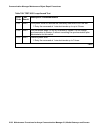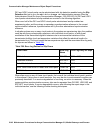
Communication Manager Maintenance-Object Repair Procedures
2144 Maintenance Procedures for Avaya Communication Manager 3.0, Media Gateways and Servers
For DS1- or BRI-based synchronization, a particular DS1 or PRI interface is configured as the
synchronization reference. The IPSI/Tone-Clock board in the same PN locks on to this
reference and regenerates clock signals that are placed on the PN’s backplane. In turn, the
Center Stage Switch (CSS) components transfer this timing to every other PN. These IPSI/
Tone-Clocks then regenerate clock signals for their own PNs at the same rate as the:
● Master PN
● Public network
This creates a hierarchy where the master PN receives timing from the public network, and
every other PN derives its timing from the master through the CSS. See Figure 123: Traditional
Sync Operation on page 2144.
Figure 123: Traditional Sync Operation
Typically, a pair of interfaces from the public network are configured — one as a primary and
one as a secondary. The IPSI/Tone-Clock in the Master PN can:
● Lock onto either interface
● Switch between them in the event of a failure
In the event of a dual failure, the Tone-Clock in the master PN can generate its own timing and
keep every PN synchronized. However, these PNs would not be synchronized with any other
public-network interfaces that exist in any of the PNs.
When a center stage is implemented via an ATM network, it is possible to obtain timing from the
ATM network. For more information, See ATM-SYNC (ATM Synchronization)
on page 610.
Master
PN
Center
Stage
Switch
Slave
PN
Slave
PN
Slave
PN
Public
Network
Primary
Secondary


















